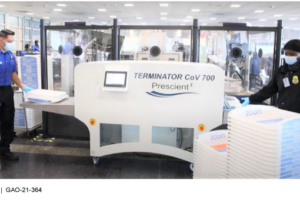TSA Could Better Monitor Its Efforts to Reduce Infectious Disease Spread at Checkpoints

Within TSA, approximately 46,000 TSOs stationed across the nation's commercial airports perform screening and other activities that often require close interaction with passengers. As a result, both passengers and TSOs may be at an increased risk of infection during pandemics such as COVID-19.
The CARES Act included a provision for GAO to conduct monitoring and oversight of the federal government's response to the COVID-19 pandemic. This report identifies 1) what steps TSA has taken to reduce the spread of COVID-19 at passenger screening checkpoints; and 2) how TSA is monitoring TSOs' implementation of amended safety and screening procedures, among other objectives.
GAO analyzed TSA data on TSOs' use of paid leave, reviewed documentation on policies and procedures, and interviewed TSA officials at headquarters and eight U.S. airports. We selected these airports to reflect diversity in the number of COVID-19 cases among TSOs, airport size, and geographic region. In addition, for six of these airports, GAO reviewed closed circuit television footage to observe how TSOs were implementing COVID-19 procedural changes.
To reduce the spread of COVID-19 at passenger checkpoints, Transportation Security Administration (TSA) officials issued amended safety measures to require that Transportation Security Officers (TSOs) use surgical masks and face shields, change gloves after pat-downs, and physically distance themselves from coworkers and passengers as practicable. TSA also adjusted some screening procedures, such as asking passengers to remove more items from carry-on baggage to reduce the potential for alarms that require bag searches. In addition, TSA modified the use of certain checkpoint screening technologies, and granted TSOs additional paid leave. In January 2021, TSA began an employee vaccination program, and is in the process of vaccinating TSA employees, including TSOs.
TSA's monitoring and analysis of its measures to reduce the spread of COVID-19 is limited. For example, supervisors' operational checklists do not specifically include the revised COVID-19 procedures, and the data that TSO monitors collect (e.g., on whether TSOs are properly wearing masks or changing gloves) reflect implementation at a point in time rather than throughout a shift. Conducting more complete monitoring would help TSA ensure that its TSOs are properly implementing COVID-19 procedures. In addition, TSA field leadership analyzes available monitoring data for different subsets of airports to understand how COVID-19 procedures are being implemented. However, TSA headquarters officials said they had no plans at the time of our review to analyze this data across all airports nationwide to identify common implementation problems, such as incorrectly wearing face shields and challenges with maintaining physical distance. Analyzing monitoring data across all airports would help TSA identify and address any system-wide deficiencies in implementing COVID-19 procedures, so that it may better protect its workforce and the traveling public.

